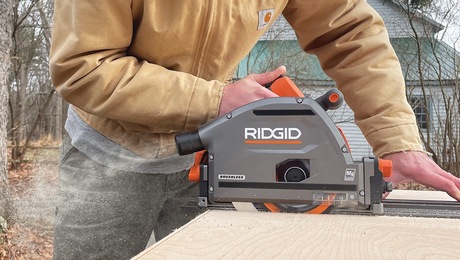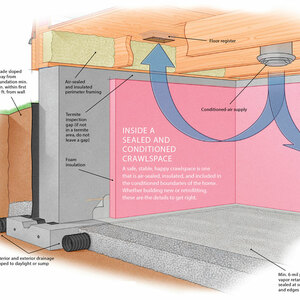1st Time Hardwood Floor install question
Hi Guys! We’re renovating a home, pulling carpet to reveal OSB and intend to install pre-finished 3/4″ wood flooring. Haven’t done this before – I know that most of you guys can do this with one hand tied behind your back – but I’d really like some advice, OK?
1. Do I put some sort of paper or plastic on the sub-floor before installing the hardwood? If so, is it Kraft paper or poly or what? What prevents it from “bunching up” or this not a problem?
2. The stairs – someone told me to build out the risers (they’re to be painted, as are the stringers) rather than adding labor-intensive stair nosing extensions. Any thoughts on this?
3. Do you undercut the door jambs and the casings, but remove the baseboard or it best to remove as much as possible?
4. When intersecting the baserail for a balustrade do you “butt up” to the existing wood with cut ends or run a prefinished board parallel to the baserail and butt up to that?
5. Any other suggestions or things that you may have learned (the hard way) over the years would be greatly appreciated. Thanks guys!
Cheers,
Ken


















Replies
I'm not a flooring expert, but have done this before. Here are my thoughts:
1. Do I put some sort of paper or plastic on the sub-floor before installing the hardwood?
Yes, Red Rosin paper. Just staple as necessary, but be sure to go over the sub floor first with a close eye toward levelling and removing any raised fasteners.
2. The stairs - someone told me to build out the risers (they're to be painted, as are the stringers) rather than adding labor-intensive stair nosing extensions. Any thoughts on this?
What are the stairs made of now, I'm assuming they were carpeted? Painting stringers? Are they exposed, or did you mean skirt boards? Don't shortcut the stairs, as they are the most visible element of your work once this is done.
3. Do you undercut the door jambs and the casings, but remove the baseboard or it best to remove as much as possible?
I prefer to remove all and reinstall after floor is in for best results. Obviously if removing means damaging nice woodwork, then undercut the jambs and casings. Since you mentioned OSB, I am guessing this is not a historical home with old-growth trim.
4. When intersecting the baserail for a balustrade do you "butt up" to the existing wood with cut ends or run a prefinished board parallel to the baserail and butt up to that?
This is a matter of aesthetics more than function, but you'd like to have an expansion joint there if the floor is running parallel to the stair opening. If perpendicular, then butt the floor boards and either install the railing on top or cover the inevitable uneven butts with trim like shoe molding.
5. Any other suggestions or things that you may have learned (the hard way) over the years would be greatly appreciated. Thanks guys!
FYI, prefinished floors come in all grades. If you're using cheap stuff from a big box store, be prepared to toss a good 20% of it during the install. You should also take great care to open the boxes and let them acclimate to the space for a good week or two. Installing floors in the dry winter months can cause you fits later if the moisture levels in the materials aren't balanced.
In any case, pay close attention to your nailing/stapling technique to avoid denting the edges and causing the finish to crack or split. Remember that scratches in prefinished flooring are White due to the zinc oxide in the formula.
I'm hoping you're renting a pneumatic nailer/stapler. I prefer staples, although that can be a somewhat religious argument with some.
You didn't mention how big the job was, but be prepared for back and knee pain since you haven't done this before. Have fun.
1. Do I put some sort of paper or plastic on the sub-floor before installing the hardwood?
fergit the rosin paper.. it'll rot away in a couple of years...
go with 15# felt...
Life is not a journey to the grave with the intention of arriving safely in a pretty and well preserved body, but rather to skid in broadside, thoroughly used up, totally worn out, and loudly proclaiming<!----><!----><!---->
WOW!!! What a Ride!<!----><!---->
Forget the primal scream, just ROAR!!!
Just how does rosin paper rot under a floor in an interior space with no moisture and/or pests? If the paper rots, then the floor is not far behind as both are wood products and susceptible to the same enemies.
The roofing felt vs. rosin paper issue has been covered here before, so I won't go into that. Suffice it to say that I prefer not to put an asphalt-impregnated product inside my home when other alternatives exist.
rot was a way to describe what happens to the paper..
after a few years you'll find the the rosin paper has desingrated..
use rosin if you wish...
Life is not a journey to the grave with the intention of arriving safely in a pretty and well preserved body, but rather to skid in broadside, thoroughly used up, totally worn out, and loudly proclaiming<!----><!----><!---->
WOW!!! What a Ride!<!----><!---->
Forget the primal scream, just ROAR!!!
Cleats vs Staples.... religious, maybe. But when you have a staple get turned by the grain of solid flooring and punch through the finish, it'll make you wish for the cleats' ability to overcome the grain.
I prefer a manual cleat nailer. It's less work to me than draggin' that darn hose back and forth. But I like to do full random on the lengths and that involves more to-and-fro.
It is satisfying to see when it's finished, whatever your preferences for the process.Troy Sprout
Socialism in general has a record of failure so blatant that only an intellectual could ignore or evade it."-- Thomas Sowell
...it'll make you wish for the cleats' ability to overcome the grain.
I have had both cleats and staples circle back up through a board though the thicker cleats have the advantage in this regard. Always the last fastener in the board too!
I prefer the staples because in my limited experience they don't seem to split the tongues of the boards as readily as cleats. This can be especially true in the lower grades of flooring where the grain is anything but straight. As always, your mileage may vary. In the end, you are right that both methods work to install a nice floor.
#15 roofing felt on the subfloor
You need to check code for risers/nosing/rise/run
undercut jambs/casing and remove base
no opinion
Buy VERY good knee pads. Rent a cleat nailer for twice as long as think you need it. Buy three times as many cleats as you think you'll need. Have a finish nailer handy (15 or 16 guage) with plenty of 2" pins... you'll have areas you can't swing the mallet for the cleat nailer.
Have a tablesaw handy for the inevitable rips to maintain 3/8 - 1/2" reveal at the walls. I like to have two 1/2" pcs of ply to set the reveal at the ends.
Buy a BIG box of Ibuprofen and take a dose PRIOR to starting. This job ain't easy on the knees or back.
Stage about five rows at a time. Keep the ends (butt joints) minimum 6" from previous row butt joints.
You're gonna cut the wrong end of a few until you get the hang of marking the lengths "upside down and backwards." Don't get frustrated.
There's lots more... but this will get you started.
Troy Sprout
Socialism in general has a record of failure so blatant that only an intellectual could ignore or evade it."
-- Thomas Sowell